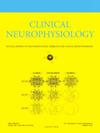Electrophysiological hemispheric asymmetries induced by parietal stimulation eliciting visual percepts
IF 3.7
3区 医学
Q1 CLINICAL NEUROLOGY
引用次数: 0
Abstract
Objective
We aimed to establish if the electrophysiological activity resulting from the direct stimulation of the intraparietal sulcus and eliciting visual percepts is hemispheric-specific.
Methods
We tested nineteen participants. Each received 360 TMS pulses at phosphene threshold intensity over right and left IPS while recording EEG. After each pulse, participants had to report if they had seen a phosphene.
Results
Parietal phosphene perception is associated with hemispheric-specific activations: phosphenes elicited by left TMS involve central and frontal electrodes at about 30 ms, and frontal, central and parieto-occipital electrodes from 120 to 250 ms; phosphenes elicited by right parietal TMS involve parietal and centro-parietal electrodes at about 60 ms, and frontal, central and parietal electrodes from 150 to 250 ms. Correlated Component Analysis shows that primary visual areas are not activated when phosphenes are produced by TMS over IPS.
Conclusions
Our results show that direct stimulation of IPS gives rise to sustained patterns of activity specific to the stimulated hemisphere. Moreover, elicited parietal phosphenes are associated with evoked activity specific to the stimulated hemisphere and located outside early visual processing areas.
Significance
This study highlights hemispheric differences in the electrophysiological dynamics related to parietal phosphenes, and shows that the dorsal pathway can give rise to visual conscious percepts.
由顶叶刺激引起视觉知觉引起的电生理半球不对称
目的探讨直接刺激顶叶内沟引起的脑电生理活动是否具有半球特异性。方法我们对19名参与者进行了测试。每个人在记录脑电图的同时,分别在左右IPS接收360次脑磁刺激阈值脉冲。每次脉搏跳动后,参与者必须报告他们是否看到了光幻视。结果顶叶磷酸化感知与半球特异性激活有关:左侧经颅磁刺激诱导的磷酸化在约30 ms时涉及中央和额叶电极,在120 ~ 250 ms时涉及额叶、中央和顶枕电极;右顶叶经颅磁刺激引起的光幻听在约60 ms时涉及顶叶和中央顶叶电极,在150 ~ 250 ms时涉及额叶、中央和顶叶电极。相关成分分析表明,经颅磁刺激产生光幻视时,初级视觉区未被激活。结论:直接刺激IPS可引起受刺激半球特异性的持续活动模式。此外,被激发的顶叶磷幻视与特定于受刺激半球的诱发活动有关,并且位于早期视觉处理区域之外。本研究强调了与顶叶磷幻视相关的脑电生理动力学的半球差异,并表明背侧通路可以产生视觉意识感知。
本文章由计算机程序翻译,如有差异,请以英文原文为准。
求助全文
约1分钟内获得全文
求助全文
来源期刊

Clinical Neurophysiology
医学-临床神经学
CiteScore
8.70
自引率
6.40%
发文量
932
审稿时长
59 days
期刊介绍:
As of January 1999, The journal Electroencephalography and Clinical Neurophysiology, and its two sections Electromyography and Motor Control and Evoked Potentials have amalgamated to become this journal - Clinical Neurophysiology.
Clinical Neurophysiology is the official journal of the International Federation of Clinical Neurophysiology, the Brazilian Society of Clinical Neurophysiology, the Czech Society of Clinical Neurophysiology, the Italian Clinical Neurophysiology Society and the International Society of Intraoperative Neurophysiology.The journal is dedicated to fostering research and disseminating information on all aspects of both normal and abnormal functioning of the nervous system. The key aim of the publication is to disseminate scholarly reports on the pathophysiology underlying diseases of the central and peripheral nervous system of human patients. Clinical trials that use neurophysiological measures to document change are encouraged, as are manuscripts reporting data on integrated neuroimaging of central nervous function including, but not limited to, functional MRI, MEG, EEG, PET and other neuroimaging modalities.
 求助内容:
求助内容: 应助结果提醒方式:
应助结果提醒方式:


